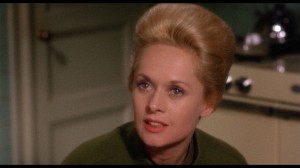Review by practicing zoologist Thorn Chen
Here’s something better and a bit more terrifying than CGI monsters: the screen flashes red when Marnie, the female lead played by Tippi Hedren, sees a bouquet of red flowers in a vase. From there on, your muscles tighten every time you see a something red in the shot. It’s like hypnosis. You brace yourself for Marnie to have another panic episode. When she doesn’t you’re relieved. When she does, and the screen flashes red again, the trigger is reinforced. It’s worked. At least for the next two hours, Hitchcock has reduced us to animals, Pavlov’s dogs in particular. At the color red, we cringe with suspense.
It’s okay, though, since Mark Rutland (Sean Connery, fresh off the sets of Dr. No) is a practicing zoologist, at least he was before he took over his father’s failing business. The first time he met Margaret “Marnie” Reynolds was when she worked secretary of one of his business associates. Back then she went by the alias Marion Holland. The film begins with her cleaning out the company safe and fleeing with a yellow alligator bag tucked under her arm. She changes her name and gets ready to do it again, except that unbeknownst to her, the owner of her next target, Rutland & Co., already knows who she is. A zoologist by training, however, Mark is more curious than threatened. He is fascinated with predators, which he considers “the criminal class of the animal world.” This he tells her in his study shortly before their questionable first kiss. So he hires her and then proceeds to fall in love. Catching her red handed in larceny, he blackmails her into marrying him, only to discover that she’s cold to the caresses of men. Obviously, for James Bon–I mean for Connery’s character, this means that there’s something wrong with her, and he switches roles from lover/animal-trapper to detective/psychoanalyst. After this, the story can only get more twisted.
Marnie is a movie with manifold layers and unpredictable swerves; underneath it all lies something very traumatic. Hitchcock will show us at the end what has made Marnie a compulsive liar and thief, but the details of the mystery’s unraveling are what make the film sometimes grueling, other times touching, and more often than not unseemly in its gender politics. Connery’s character is a charming but sadistic man determined to possess Marnie and set her right. As the French critics of Cahier du Cinema once pointed out, the film is indeed all about men possessing women, something that can be gleaned from the very beginning when we see the title cards printed ALFRED HITCHCOCK’S MARNIE. But Hedren’s character is perhaps more than an enigma to be solved and a case to be cured by the former zoologist. Besides for being afraid of lightning and the color red she has a strong attachment to animals and to her mother. As in The Birds (1963), mothers and animals seem to represent the same uncontrollable force. What do Marnies’ attachments mean? No doubt it’s up to the viewer to decide. In any case, Hitchcock’s characteristic precision with repeating image and rhythmic cues do bring us along for the ride. As with the other Hitchcock films, Marnie ends with the restoration of the heterosexual union, but what transpires in the middle is quite worth watching. — Thorn Chen
Thorn Chen is from New York, now in Minneapolis pursuing a PhD at the U, where he writes about Chinese educational films, reads continental philosophy, and scrounges for funds to support his coffee addiction.
MARNIE screens Monday, May 4 at 7:00 at the Riverview. Advance tickets are $8.00, and you can purchase them here.

